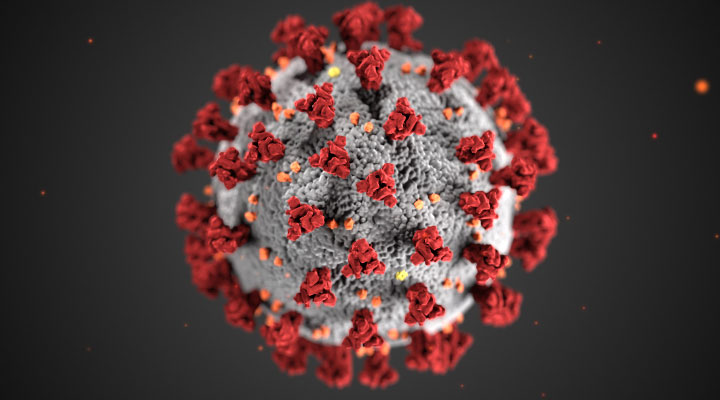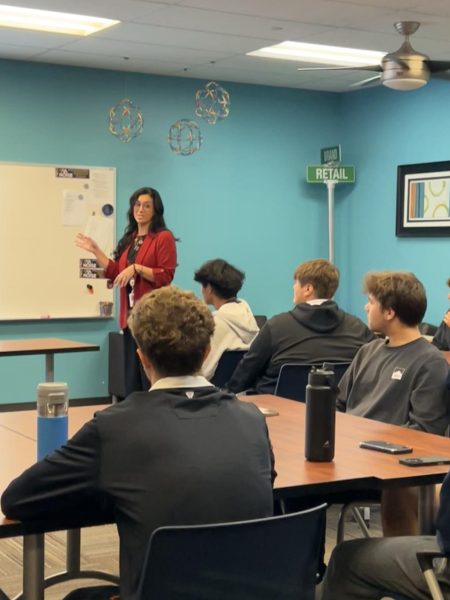Omicron Impacts January Reopening
CDC / Public Health Image Library
The omicron receptor-binding domain (RBD) and N-terminal domain (NTD) both have 15 and 11 mutations, respectively, which cause a significant reduction in plasma neutralizing activity in infected or vaccinated people, which means there is a significant reduction in antibodies to fight the virus.
Due to the December surge in COVID-19 cases in Northeast Ohio caused by the highly-infectious omicron variant, Beachwood administrators made some adjustments in order to keep people safe.
The return to school after winter break was delayed by two days for teachers and three days for students.
District administrators explained the reasoning for the delay in a memo sent Dec. 28.
“This delay will provide more time before reopening after winter break to receive staff and student test results, determine the extent of virus spread and any staffing level implications,” the memo stated.
In addition to the delayed start, participants in sports and other extracurricular activities, as well as coaches and advisers, were required to take COVID tests for at least three weeks, even if they were vaccinated.
The district provided free PCR tests to be taken at school buildings each week on Mondays.
Beachwood has access to hundreds of PCR COVID tests through the Midwest Coordination Center.
“We decided to do [PCR testing for three weeks] because we know with omicron surging right now in northeast Ohio that there will be a strong chance we will have a number of people who are COVID positive who don’t even know it,” Superintendent Dr. Bob Hardis said. “Then potentially, they could spread it. Particularly, if they are involved in extracurricular activities where they may, as an example [in sports], compete.”
“If omicron has a crest and a sharp decline, which is what other places around the world have seen, we want to do everything we can to stop it from peaking really high and quickly end it,” he added.
On Jan. 20, Hardis sent an email to families announcing that the district has seen a rapid decline in COVID cases and would no longer require weekly testing for vaccinated students and staff involved in extracurriculars.
At the high school, Principal Paul Chase opened the cafeteria for freshman and sophomore lunches, allowing juniors and seniors to spread out in the community room and cafeteria in order to increase social distancing.
Sports were put on hold from Dec. 27-Jan. 7, a critical period for winter athletes.
Additionally, spectators at sporting events were minimized to two guests per participating student.
“A lot of our coaches and our athletes were very discouraged that we put a pause on athletics,” Athletic Director Ryan Peters said. “But I think if everyone took a step back and looked at why, they would see it was the right decision to slow things down… We want to make sure everyone is safe before we rush back into athletics.”
“Our number one objective is always to keep our students and our staff healthy and safe,” he added.
Senior David Kuang regrets the impact of these safety measures on his classes and extracurricular activities.
“When we were told that we were not able to do any labs or activities, I feel it made school a lot more boring and hindered my learning,” he said.
“I understand that the school district is taking these measures to maintain the highest level of safety inside the school,” he added. “But it’s taking a huge toll on extracurricular activities, especially the ones that I’m leading because I can see it’s dramatically affecting attendance.
Senior Amelie Cotta had a positive spin on the delayed restart.
“The three-day delay kind of just pushed back a couple of tests,” she said. “That was actually sort of a blessing for my grade. So the late restart did pause some activities, but we just picked back up where we left off.”
At publication, Cuyahoga County COVID rates seem to have crested, but are still higher than they were in the fall.
So Why is Omicron So Virulent?
On Nov 24, 2021, South Africa notified the World Health Organization (WHO) of the discovery of a new SARS-CoV-2 mutation, which epidemiologists know as B.1.1.529, and which is now known as omicron.
Omicron was first discovered in specimens collected on Nov. 11, 2021 in Botswana and Nov. 14, 2021 in South Africa.
Since November, omicron has spread worldwide faster than any other known type of coronavirus. While scientists are still learning a lot about omicron, the variation is already generating an increase in new cases, which has increased both hospitalizations and deaths and overwhelmed hospitals in Cleveland and around the country.
Omicron, which is currently known as the variation of concern (VOC) defined by the World Health Organization, has the highest number of mutations of all of the variants thus far, and is spreading at an unprecedented rate, evading antibody-mediated immunity, making it significantly more infectious than any other variant.
On the surface of human cells are spike-like proteins known as angiotensin-converting enzyme 2, commonly referred to as the ACE2 receptor. Viruses, on the other hand, contain short immunogenic segment located on the spike of the virus known as the receptor binding domain.
Using the spike-like protein on the exterior layer of our cells, the omicron receptor binding domain attaches to the ACE2 receptor, which provides an entry point for the coronavirus to latch onto and attack the cells.
Imagine the omicron virus’s receptor binding domain as a key looking for a door to unlock, while the ACE2 receptor is the lock on the door. So, when the omicron receptor binding domain binds to the ACE2 receptor, it is like a key being put into a lock.
Once the omicron receptor binding domain binds to the ACE2 receptor, the lock is opened, and the virus accesses a door to invade the cell. The omicron virus is thus able to enter and invade our cells through the ACE2 receptor, which acts as a “cellular doorway” for the virus that causes omicron.
“There is some preliminary evidence suggesting the omicron variant is more infectious than the delta variant,” said Dr. Robert Bollinge, Professor of Infectious Diseases at Johns Hopkins University.
The unique way that the Omicron receptor binding domain binds to the ACE-2 receptor could result in how infectious the virus is.
“But other changes might make it so that the virus binds just that much better to the ACE-2 receptor,” said Dr. Peter A. Zimmerman, a professor of pathology at Case Western Reserve University.
The main set of DNA variations of the omicron spike glycoprotein, which stimulates viral entrance into cells, has an astounding 37 residue mutations, compared to the 10 such changes in both the SARS-CoV-2 Alpha and delta, which could hint to why omicron is so infectious.
The omicron receptor-binding domain (RBD) and N-terminal domain (NTD) both have 15 and 11 mutations, respectively, which cause a significant reduction in plasma neutralizing activity in infected or vaccinated people, which means there is a significant reduction in antibodies (what fights the virus).
Despite 15 residue changes, the omicron RBD retains high affinity attachment to human ACE2 receptor, the key entryway receptor and, with the exception of two mutations, all authorized or approved therapeutic monoclonal antibodies (mAbs) lost their neutralizing efficacy against omicron as a result of this antigenic change.

Samah Khan (she/her) started writing in the fall of her sophomore year in 2020. She enjoys covering macroscopic world issues and their impacts on the Beachwood...

Lana Lagman (she/her) began writing for the Beachcomber in the fall of 2020. She likes to cover stories concerning mental health, diversity and new medical/scientific...

Amy Zhou (she/her) started writing for the Beachcomber in 2021. She enjoys writing news occurring in Beachwood, and occasionally an opinion piece. Outside...






![“My parents have always said that education is important. My parents are Chinese immigrants, I'm Chinese American, [and that's a] value that has always been ingrained in our community,” said Senior Lyndia Zheng, pictured with Tony Zheng](https://bcomber.org/wp-content/uploads/2025/10/DSC_4244-600x400.jpg)




